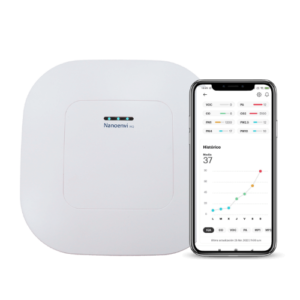The role of preventive medicine in hospital construction sites is no easy task, especially when the building is at the epicentre of the construction work.
In this article, Dídac López Toledano, Director of Maintenance at Manacor Hospital, tells us about the problems they faced when Manacor Hospital embarked on its project to double its surface area and how, thanks to Nanoenvi IAQ Indoor Air Quality monitoring system and its data visualisation platform, they were able to guarantee the required environmental safety conditions at all times.
Preventing airborne dust in a construction site environment
Anyone who has worked on or witnessed a construction site can say, in colloquial terms, that “a lot of dust is raised”.
Now let’s transfer this image to a hospital environment where people are constantly coming and going, and where it is not only the airborne dust from the construction site that needs to be controlled, but also the levels of particulate matter in order to comply with indoor air quality regulations and minimise the risk of nosocomial infections.
This is extremely important because most microbiological contamination is associated with inert particles such as dust, which act as protective and transport elements for spores, fungi such as aspergillus, micrococcus or bacillus, among others.
The conclusion is clear: it is a challenge for Dídac’s team.
“Given the scenario in which we found ourselves, it was essential to know at all times that we were within the limits of environmental safety and that we had no contamination of any kind as a result of the work”. – Dídac López, Maintenance Manager at Manacor Hospital.
The question was no longer just what indoor air quality parameters to monitor, but where to monitor them and what system could provide them with continuous and easily accessible data.
Solution: Networking of continuous air quality measurement systems from outside to critical areas of the hospital with Nanoenvi IAQ
Once it was clear to Dídac and his team that they needed to install a whole network of monitoring and detection IAQs for particulate matter PM and other related parameters, they decided that these would be installed from the outside entrance doors to the most critical areas of the hospital.
In addition, to make the data as reliable as possible, pre-construction measurements were started four months in advance in order to know the baseline “zero point” and then to be able to follow up and take the necessary measures during construction.
Main advantages of the Nanoenvi IAQ indoor air quality meter
“When it comes to making decisions, it is important to have a history of what has happened and how, to understand how the hospital works and its own inertia” – Dídac López
 High sampling rate
High sampling rate
This allowed the hospital to know the actual situation at all times and to take action if the set optimum limits were exceeded.
 Real-time data and historical charts
Real-time data and historical charts
It allows a personalised study of a period of time.
 Immediate access to information
Immediate access to information
Thanks to the data visualisation platform accessible from any device with internet access.
 Easy to install
Easy to install
Its small size and ease of installation allow it to be placed anywhere and even moved to other areas to monitor different zones.
Measuring indoor air quality as an occupational risk prevention measure
Although the need for this air quality measurement came from the Hospital Hygiene Department, the data provided by the sensor is so reliable and interesting that other departments, such as the Occupational Risk Prevention Department, have used it for their own reports and analysis of corrective measures.
Dídac explains how his colleagues in the (PRL) department have started to use this Nanoenvi sensor network to quickly and effectively measure and control the parameters of CO2, temperature, humidity, volatile organic compounds and PM10 and PM2.5 particles in accordance with RITE regulations and air renewal in hospitals, so that they know for sure what is happening with the air quality in the building and what preventive measures need to be taken.
Conclusion: preventive medicine on hospital construction sites works
In many cases it is essential to think outside the box, and this is what Dídac López, head of maintenance at Manacor hospital, did when he considered how to ensure the indoor air quality in his hospital as they tackled a major project to double the surface area of the building.
Dídac had a clear idea of what, how and where to monitor air quality, so he turned to Envira to create a network of continuous measurement systems with Nanoenvi IAQ devices.
The precision and possibility of visualising the measurements in real time to know exactly what is happening at all times, the availability of historical data graphs and its easy installation that even allows the device to be moved to different spaces are some of the features that have been most valued, being so useful that they have come to use them in various applications in different departments of the hospital itself.











